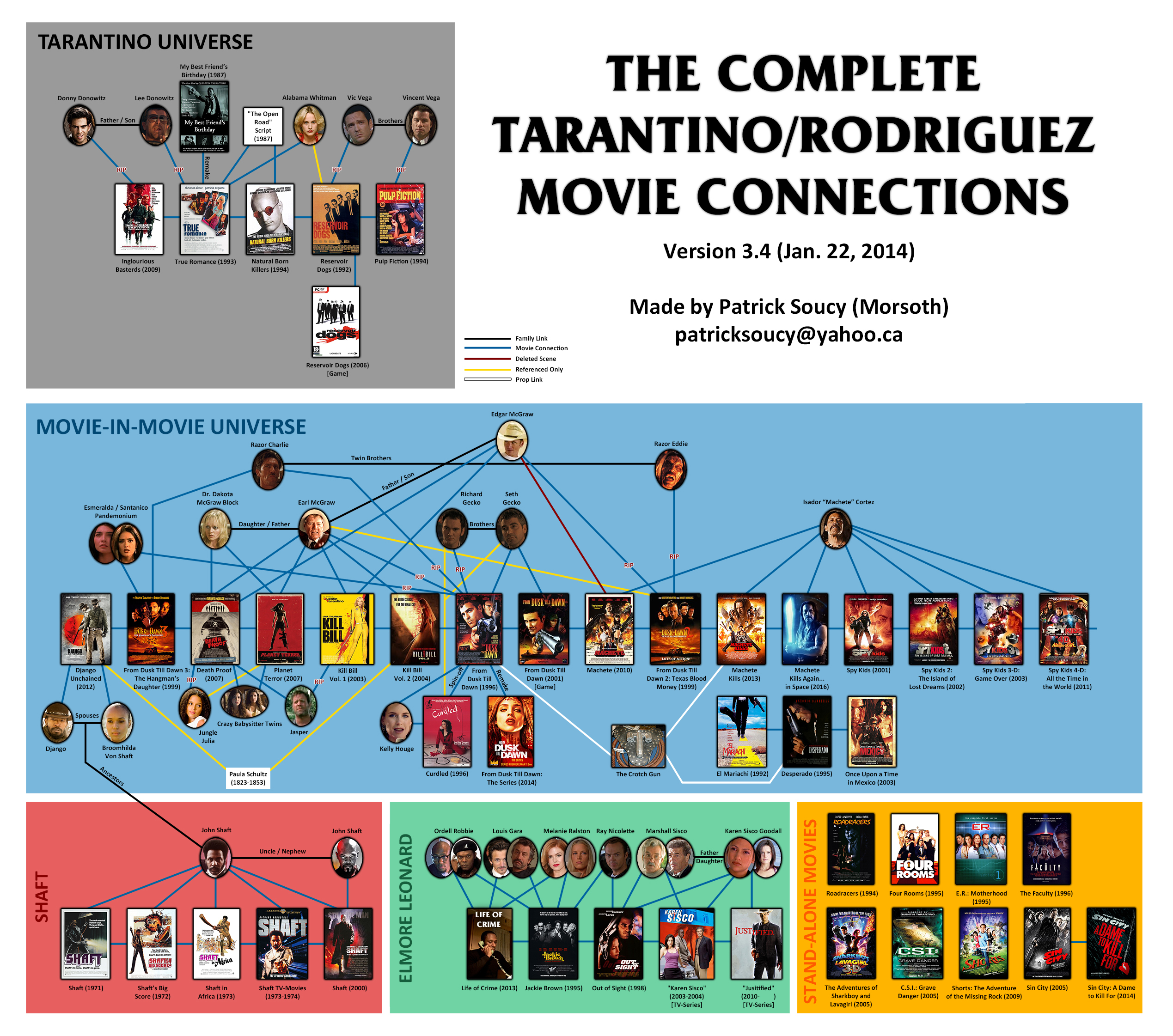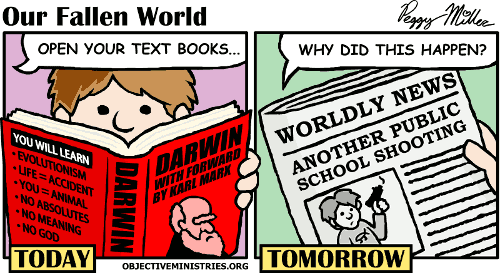
It takes a special sort of artist to be the subject of conspiracy theories that make their work more compelling. Not less. The Internet is full of bad conspiracy theories about art. Theories that draw from the same gene pool as the backwards masking movement from the early days of rock music. Theories that see ghosts operating in the machine. Theories from the Third Eagle of the Apocalypse. Theories are a dime a dozen. There are five that I choose to believe.
- Radiohead orchestrated a secret album within two albums called 0110 (previously).
- TV writers are trying to organise cross-overs between characters (not actors) from a range of programs that means most of the TV we consume is happening within the dreams of a character named Tommy Westphall from a show you’ve probably never heard of (previously).
- Pixar’s movies are all united in the same universe (previously).
- The Office UK and the Office US exist in the same universe and thus broke any laws of probability by the exact same day happening in two offices across the Atlantic (previously)
- Quentin Tarantino’s movies are all either set in the same universe, or are movies watched by people who live in that universe (more).
What I love about these is they are all (if true) demonstrations of intricate creativity being deliberately laid out over a significant amount of time with a huge degree of deliberation. If true they are the work of master craftspeople. People at the top of their creative games, and at the top of the creative game. The beauty of these theories (well not really the Office one – it’s just fun) is that you don’t have to notice them to appreciate the individual texts (movies and albums) involved, but when you do notice them, or experience them through the lens the theories provide, there is a greater richness in the experience and a greater appreciation of the mastery on display.
I choose to believe that Tarantino is a master story teller. A master of very deliberate decision making in the creative process. I think the best stories are layered. They reward multiple readings (or viewings). They get richer over time, not simpler.
My working theory in this post is that God is the ultimate deliberate creator. The ultimate story teller. And when we drill down into what makes excellent human story telling excellent we gain a new appreciation of the excellence of the story God has been telling since before the beginning of time that includes, but is not limited to, the story told by the Bible (I say this because I think a case can be made that the Bible is a demonstration of the story God has been telling through history since he created the world.
Tarantino’s approach to telling stories through deliberate and intricate plots helps me appreciate the story of the Bible.

Image Credit: IGN, The Intricate, Expansive Universe of Quentin Tarantino.
What the Bible is…
Like Tarantino’s movie corpus which includes all his films, occuring within one universe, the Bible is a collection of books put together across a span of time. Christians believe the creative intent behind the linking of these books and the stories and story they tell is the result of the deliberate creativity of a divine author – God – who doesn’t just deliberately author these texts with a particular creative intent, but all of human history.
The Bible is a set of books that work as discrete units with specific purposes that tell complete stories, books that form part of different genre based corpora (like the Law, the Writings, and the Prophets in the Old Testament. Just as Kill Bill is one story told over two episodes to give Tarantino more space, there are narrative based books of the Bible that come in two parts – like 1-2 Samuel, Kings, and Chronicles. The books in the Old Testament often include a variety of sources and references to other texts in their time – Proverbs, for example, includes references to several foreign kings whose collections have been included in Israel’s official collection of theological wisdom. Genesis contains Jewish versions of stories (like the flood) that are retold by other cultures with other emphases (see, for example, the Gilgamesh Epic). The Bible uses these stories with a particular agenda according to God’s purposes. The Bible doesn’t contain all the stories God is telling in his world, because: a) there isn’t enough room, as John says at the end of his Gospel…
“Jesus did many other things as well. If every one of them were written down, I suppose that even the whole world would not have room for the books that would be written.” – John 21:25
b) every human life is a story, and part of this story. Like in Tarantino’s movie universe – All these stories – the stories told in the Bible, and the stories told in history through our lives, are connected through God’s meta-narrative. The story of his son. Jesus.
Like Tarantino’s movies, this story involves an act of hyper-violence. The story of the Bible (at least so far as it claims it is one story) is the story of the lamb slain before the creation of the world – and how that slaying plays out for each one of us. Are we slayers or was he slain for us? How’s this stuff from Revelation 13 for Tarantinoesque… Just let the symbolism of this stuff wash over you – the really important bit is in the bolded verse, but that only really makes sense in its context.
People worshiped the dragon because he had given authority to the beast, and they also worshiped the beast and asked, “Who is like the beast? Who can wage war against it?”
The beast was given a mouth to utter proud words and blasphemies and to exercise its authority for forty-two months. It opened its mouth to blaspheme God, and to slander his name and his dwelling place and those who live in heaven. It was given power to wage war against God’s holy people and to conquer them. And it was given authority over every tribe, people, language and nation. All inhabitants of the earth will worship the beast—all whose names have not been written in the Lamb’s book of life, the Lamb who was slain from the creation of the world. – Revelation 13:4-8
We all play a part in God’s story – either we’re on team dragon or team lamb. And God’s story centres on this one particular violent event. Deliberately. As Peter puts it in Acts 2 when he speaks to the Jewish crowd the narrative of Luke-Acts holds responsible for killing Jesus…
This man was handed over to you by God’s deliberate plan and foreknowledge; and you, with the help of wicked men, put him to death by nailing him to the cross. – Acts 2:23.
This chapter comes soon after (but in volume 2) Luke records Jesus telling us how to read the Bible as one intricate story with one agenda.
“He said to them, “This is what I told you while I was still with you: Everything must be fulfilled that is written about me in the Law of Moses, the Prophets and the Psalms.”
Then he opened their minds so they could understand the Scriptures. He told them, “This is what is written: The Messiah will suffer and rise from the dead on the third day, and repentance for the forgiveness of sins will be preached in his name to all nations, beginning at Jerusalem.” – Luke 24:44-47
This mind opening that Jesus performs for his disciples is something like that light that turns on when you hear the theory that Tarantino’s movies are all connected. It’s what happens when you’re given the key to understanding a bunch of stories you’d never quite connected.
Look. The Bible’s writers could have made all this stuff up. Maybe. I’m familiar with the argument about puddles that some people believe does away with the need for an intelligent designer in a fine-tuned universe. And I’m really advocating a view of a finely told story… And this construct Jesus suggests for reading the Bible actually does work, it gives us (or at least me), a particularly satisfying approach to an ancient text, tracing myriad threads through the Old Testament to the foot of the Cross and the feet of King Jesus. This could be the work of some very clever humans. It could be an artificial frame to put around a bunch of random text – as a hole in the ground is a random frame that perfectly encompasses a puddle… But bear with me for a moment.
Consider the crucifixion of Jesus as a massive triumph of deliberate planning. The orchestration of literature, events, and human behaviour. Masterfully woven together. Where written story (the Old Testament) and human history come together in an utterly sublime, but yet totally surprising, way. I love reading essays like I, Pencil (which is also a YouTube video now), or a recent article about Thermos sending a hot coffee by freight across the US, and all the things that have to fall neatly into place in the supply chain to get that coffee from farm to mouth.
I love thinking about the intricacies and deliberation required to achieve certain desired results.
I love the idea that true creativity is about finding an intricate, elegant (aesthetically pleasing), or deliberately and aptly selected (sledgehammers can be creatively applied) approach to achieving such results. This is why I love Rube Goldberg machines and OK Go film clips and uphold them as archetypal forms of creativity or ingenuity. It’s why I enjoy Tarantino movies and the theory they all take place in the same interwoven universe. They are examples of intricate, elegant, and deliberate story telling. But they are not the ultimate version of this sort of storytelling…
What is more intricate, elegant, and deliberate than having human history unfold in such a way that a specific person, born in a specific place, to a specific category of mother, killed by specific people, in a specific way, with specific events plausibly surrounding this specific death? That sounds a little like a potential plot line for a Tarantino movie. The ‘deliberate’ planning involved to get Jesus to the Cross blows my mind…
Consider the deliberate marshalling of human history and events both local and geo-political in order to have Jesus killed through an unexpected agreement between a particular surviving people group from the Ancient Near East (whose very survival was unlikely) – Israel – who believed that being hung on a tree was a sign of God’s curse and their bitter enemy – the occupiers – Rome – the most powerful human empire and propaganda machine the world had ever seen, who used crucifixion as a violent symbol in a PR war to keep sedition at bay.
Consider the sheer unlikelihood of the rise of Christianity amongst both Jews, with their views on crucifixion – theologically driven, and ancient, and Romans. Jews looked at crucifixion through the lens of Deuteronomy 21, which says:
“If someone guilty of a capital offense is put to death and their body is exposed on a pole, you must not leave the body hanging on the pole overnight. Be sure to bury it that same day, because anyone who is hung on a pole is under God’s curse.” – Deuteronomy 21:22-23
While Romans had the rhetorical power of the cross hammered into them by its use in events like the crucifixion of Spartacus’ army in 73BC. Where 6,000 Roman slaves were executed and displayed for all to see on the Appian Way – a 200km highway between Rome and Capua.
Consider that crucifixion was so violent and barbaric that Roman citizens were not permitted to be crucified. That sort of cultural aversion had to be developed in order for the cross to have its inverted rhetorical power in the Christian story. In order for its sheer unlikelihood as a means of heralding and coronating a king to be significantly subversive.
That’s the level of intricacy in this story’s supply chain.
That’s the sort of creativity involved in God’s story-telling.
Even if the puddle theory could be applied to this level of fine-tuning – there’s a sublime amount of creativity applied to weave all these elements together across genres, languages (from Hebrew to Greek (via Aramaic), through different political regimes (the nomadic patriarchy, the Jewish monarchy, exile under Assyria, exile under Persia, the return from exile, exile under Greece, exile under Rome), and to link them with an incredibly consistent application of tropes, and amazingly intricate intertextuality (both inside and outside the Biblical canon).
Whatever the explanation for the creative force behind this intricacy – be it a cabal of human editors working over that span to advance some sort of nefarious agenda (or simply for creativity’s sake), or divine (and I’m not sure the human alternative is all that plausible, even if I’m a sucker for creative literary conspiracy theories) – it is sublimely creative and exciting. It is deliberate, intricate, and elegant.
This is what sets the Bible’s story apart from the rest, in the same way that Tarantino’s movies sit apart from contemporary works or those within similar genres. But here are three areas where appreciating the deliberation and creativity in Tarantino’s movies helps me to get a sense of the greater creativity at play in the pages of the Bible – a much older text.
Intertextuality
One of the interesting implications of the Tarantino theory (certain parts of which have been confirmed) is what it means for all the movies from our real universe that Tarantino references in his “realer than real” universe and also in the “movies that exist within the realer than real” universe. His movie universe is a movie universe where most of our texts also exist (in order for them to be referenced in whatever homage he chooses to pay them). Curiously. The Bible exists in the Tarantino universe. Pulp Fiction hitman, Jules Winnfield, quotes Ezekiel as he shoots his victims. Only. He doesn’t. This is what Jules says:
“The path of the righteous man is beset on all sides by the inequities of the selfish and the tyranny of evil men. Blessed is he who, in the name of charity and good will, shepherds the weak through the valley of the darkness. For he is truly his brother’s keeper and the finder of lost children. And I will strike down upon thee with great vengeance and furious anger those who attempt to poison and destroy my brothers. And you will know I am the Lord when I lay my vengeance upon you.”
Ezekiel 25:17 actually says:
“I will carry out great vengeance on them and punish them in my wrath. Then they will know that I am the Lord, when I take vengeance on them.”
That’s a distraction from this concept of intertextuality. Intertextuality – speaking to, and with, other texts from within a text, is a sure-fire way to create intricacy and integration.
There’s quite a bit of language in this video that claims to contain every pop culture reference Tarantino makes in his movies. This “definitive guide” goes beyond mentions of other cultural artefacts within Tarantino’s work to explore the way he pays homage to a wide variety of texts. Here’s how the characters in his movies (and the movies of Robert Rodriguez) are interconnected.

Image Source: The Adventures of an Insomniac
The Bible is chock full of cross-references – interactions with other cultural texts, for sure, but the incredible number of cross references between the 66 books that became the Christian Bible is quite amazing. There are 63,000 cross references in the Bible depicted in this graphic.

Some of these cross references are more hefty than others – but the way the Bible links the words of the prophets in the Old Testament with the actions and words of Jesus is pretty stunning story-telling (more stunning if the connections are what actually happened, not just things creative writers invented – and I believe they are). This sort of intertextuality is Tarantino on steroids – that definitive guide to Tarantino, impressive though it is, contains 179 examples. Examples from one guy. From 18 of his movies. This infographic depicts about 352 times the number of references Tarantino managed, from 66 books, written by about 40 authors. The Bible’s intertextuality, in my opinion, is significantly more impressive because of the integration of the creativity of so many people, over so long, to tell a coherent story that also does both pop culture references and references within the universe of the Biblical texts.
As far as I’m concerned there are two options with the Bible. It is definitely an amazingly integrated story full of deliberation, intricacy and elegance – transcending a bunch of archaic genres that we aren’t particularly well equipped to grapple with. This story is either fiction, invented by a string of genius Tarantino like humans, operating across cultures, or it is truth, divinely authored through a string of genius Tarantino like humans. I like the concluding remarks from the essay I, Pencil mentioned above, at this point. I think what is true in this paragraph about the making of a pencil is truer about the writing of the Bible.
“I, Pencil, am a complex combination of miracles: a tree, zinc, copper, graphite, and so on. But to these miracles which manifest themselves in Nature an even more extraordinary miracle has been added: the configuration of creative human energies—millions of tiny know-hows configurating naturally and spontaneously in response to human necessity and desire and in the absence of any human master-minding! Since only God can make a tree, I insist that only God could make me. Man can no more direct these millions of know-hows to bring me into being than he can put molecules together to create a tree.”
The use of tropes (type-scenes, reoccuring metaphors, images, objects, patterns, or ideas) in both narrative and meta-narrative
Tarantino has certain trademarks – some more offensive than others – that reoccur throughout his movies. These serve to link the movies together as ‘Tarantino’ movies. They are part of his distinctives. They are part of his personality.
The Bible is chock full of trademarks, or motifs, that reoccur across different books. There are also threads that carry the narrative across these books, through the cross references depicted above, to link the books of the Bible as one unfolding story. That’s part of the added appeal.
Here are just a few.
1. Women who can’t conceive falling pregnant and giving birth to a miraculous child after being visited by a messenger from God, the child then plays a significant part in God’s rescue plan. Starting with Abraham and Sarah (Isaac), then Jacob and Rachel (Joseph), then Sampson’s parents (his mother isn’t named), Elkanah and Hannah (who have Samuel), Zechariah and Elizabeth (John the Baptist), then, of course, Mary – the most unlikely mother – gives birth to Jesus.
2. Animal interactions as indicative of God’s judgment, or humanity’s obedience to God. From the snake in the garden, to Balaam and his talking donkey, to Jonah and the whale, to Elisha and his attack she-bears, to Sampson and David ripping apart lions and (not tigers) bears as signs of strength, animals are a reoccuring plot device in the Bible.
3. Gold. There’s Gold in Eden, at the start of the Bible, and from there on, gold (and the jewels also mentioned in Genesis 2) becomes like a thermometer that tests the temperature of humanity’s relationship with the creator and his world. The gold is plundered from Egypt during the Exodus, used to make a golden calf when Moses gets the 10 Commandments, used to construct the Temple and the clothes of the priests, and then the temple treasures are handed over to the bad guys on Israel’s road to exile.
4. Character names as determinative puns. Right from Adam, whose name means “of the ground” to Jesus, whose name means “God with us” – the Bible uses character names to move plot, and indicate where things have changed – for example, when Abram’s name is changed to Abraham.
5. Numbers. The Bible uses reoccuring numbers – like 12 (tribes and disciples) and 40 (days of rain for Noah, years in the wilderness for Israel, days in the desert for Jesus) – to link stories and events.
There are also tropes within books. Genesis, which starts in the Garden, spends the rest of the book playing with the idea of ‘seed’ – including the weird story of Onan. Judges is full of people killing using improvised weaponry. 1-2 Samuel reads like a mafia novel – Kings (or Godfathers) rely on their hitmen (Abner for Saul, Joab for David) to carry off increasingly nasty hits. Quite a few books in the histories section involve stories about people building markers to recognise significant places or events that are said to “remain till this day”…
My favourite thread that helps carry the narrative is the good old “image of God” thread – which isn’t just about the ideal human and our relationship to God, but is a constant criticism of the idolatry of the nations that Israel keeps taking up. People are meant to be living images of the living God, but they’re so keen to make dead images (still, wooden, stone, or metal) of dead gods. This thread helps explain the prohibitions against making images of God, and the problems Israel have with being the people God wants them to be. The Bible is pretty clear that the things we make our gods shape us. When Israel is shaped by the living God things are good (this doesn’t happen often), when they are shaped by idols, they die. This carries through to Jesus, who the Bible tells us is the image of God. Who transforms dead people who have turned away from God into live people, reconnected with God. It’s a big story of recreation – the end of the Bible, Revelation, is a perfect world, with a Garden, where God is present with people restored to his image.
The individual integrity and brilliance of the parts but greater integrity and brilliance of the canon
I like some Tarantino movies better than others. I can appreciate things about his movies that I don’t like. But this Tarantino universe theory – and the ingenuity underpinning it – excites me. It opens up new ways to appreciate each movie. The connection to something bigger makes the individual movie richer. Each movie stands on its own. Each movie is a coherent and discrete unit. But they’re linked – not just by the name on the can. Tarantino. But by the use of tropes, by the intertextual approach, the signature style, all that stuff. The more aware of this stuff I am, the more I appreciate about Tarantino’s work.
It’s the same with the Bible. Each book of the Bible offers something different (maybe with the exception of Chronicles as they relate to 1-2 Samuel and 1-2 Kings). Each stands alone as art. Each is a work of creativity. Each has a relatively clear meaning and purpose – but this clarity becomes richer with time, the more one understands the creativity at play in the text. The books that take a narrative form stand alone as stories with beginnings and endings. With characters. With a purpose. With the artistic development of ideas and images. But what makes the Bible really sing is when each book takes its place next to the others as this unfolding story. God’s story. The story that brings all the tropes, all the threads, all the events, together in one person. Jesus. God’s king. The king anticipated by the Old Testament. The author writing himself into the story in order to be known. The master story teller who becomes part of the story, and dies for the sake of the characters he loves. That’s when the story becomes deliberate. Intricate. Elegant. And a model of creativity at its most sublime.












